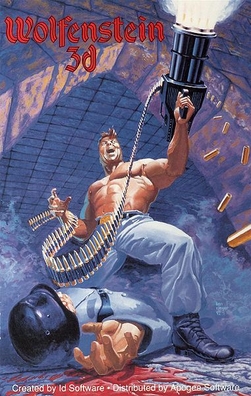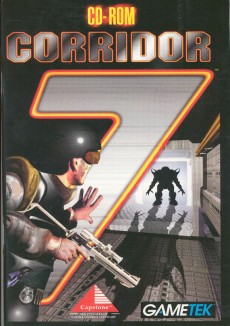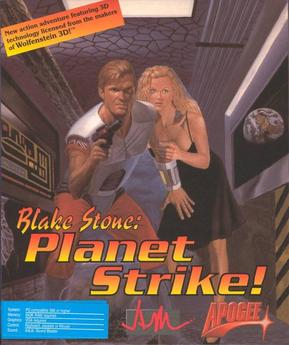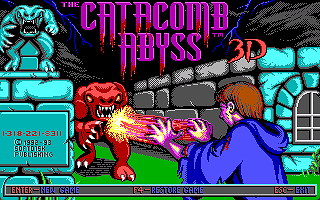
Doom is a first-person shooter game developed and published by id Software. Released on December 10, 1993, for DOS, it is the first installment in the Doom franchise. The player assumes the role of a space marine, later unofficially referred to as Doomguy, fighting through hordes of undead humans and invading demons. The game begins on the moons of Mars and finishes in hell, with the player traversing each level to find its exit or defeat its final boss. It is an early example of 3D graphics in video games, and has enemies and objects as 2D images, a technique sometimes referred to as 2.5D graphics.

Rise of the Triad: Dark War is a first-person shooter video game, developed and published by Apogee Software in 1995. The player can choose one of five different characters to play as, each bearing unique attributes such as height, speed, and endurance. The game's story follows these five characters who have been sent to investigate a deadly cult, and soon become aware of a deadly plot to destroy a nearby city. Its remake was designed by Interceptor Entertainment and released by Apogee Games in 2013. The shareware version of the game is titled Rise of the Triad: The HUNT Begins.

Wolfenstein 3D is a first-person shooter video game developed by id Software and published by Apogee Software and FormGen. Originally released on May 5, 1992, for DOS, it was inspired by the 1981 Muse Software video game Castle Wolfenstein, and is the third installment in the Wolfenstein series. In Wolfenstein 3D, the player assumes the role of Allied spy William "B.J." Blazkowicz during World War II as he escapes from the Nazi German prison Castle Wolfenstein and carries out a series of crucial missions against the Nazis. The player traverses each of the game's levels to find an elevator to the next level or kill a final boss, fighting Nazi soldiers, dogs, and other enemies with a knife and a variety of guns.
Commander Keen is a series of side-scrolling platform video games developed primarily by id Software. The series consists of six main episodes, a "lost" episode, and a final game; all but the final game were originally released for MS-DOS in 1990 and 1991, while the 2001 Commander Keen was released for the Game Boy Color. The series follows the eponymous Commander Keen, the secret identity of the eight-year-old genius Billy Blaze, as he defends the Earth and the galaxy from alien threats with his homemade spaceship, rayguns, and pogo stick. The first three episodes were developed by Ideas from the Deep, the precursor to id, and published by Apogee Software as the shareware title Commander Keen in Invasion of the Vorticons; the "lost" episode 3.5 Commander Keen in Keen Dreams was developed by id and published as a retail title by Softdisk; episodes four and five were released by Apogee as the shareware Commander Keen in Goodbye, Galaxy; and the simultaneously developed episode six was published in retail by FormGen as Commander Keen in Aliens Ate My Babysitter. Ten years later, a homage and sequel to the series was developed by David A. Palmer Productions and published by Activision as Commander Keen. Another game was announced in 2019 as under development by ZeniMax Online Studios, but was not released.

Corridor 7: Alien Invasion is a first-person shooter video game developed by Capstone Software and published by IntraCorp and GameTek. The game received poor reception, largely due to its use of the outdated Wolfenstein 3D engine. A sequel, Corridor 8: Galactic Wars, was announced but later canceled.

Catacomb 3-D is a first-person shooter video game, the third in the Catacomb series, the first of which to feature 3D computer graphics. It was developed by id Software and originally published by Softdisk under the Gamer's Edge label, released in November 1991. The player takes control of the high wizard Petton Everhail, descending into the catacombs of the Towne Cemetery to defeat the evil lich Nemesis and rescue his friend Grelminar.
Tom Hall is an American game designer best known for his work with id Software on titles such as Doom and Commander Keen.

Nitemare 3D is a horror-themed first-person shooter released by Gray Design Associates in 1994 for MS-DOS and Windows 3.x. There are three episodes with the first episode released as shareware and ten levels in each. The full release came on two 3½" floppy disks with a guide to the game's thirty levels. According to author David P. Gray, the game is the first pixelated Windows game to use the WinG interface.
Doom, a first-person shooter game by id Software, was released in December 1993 and is considered one of the most significant and influential video games in history. Development began in November 1992, with programmers John Carmack and John Romero, artists Adrian Carmack and Kevin Cloud, and designer Tom Hall. Late in development, Hall was replaced by Sandy Petersen and programmer Dave Taylor joined. The music and sound effects were created by Bobby Prince.

Blake Stone: Planet Strike is a first-person shooter video game, the sequel to Blake Stone: Aliens of Gold, made by JAM Productions and released for DOS on October 28, 1994, by Apogee Software.

Bio Menace is a 1993 game developed and published by Apogee Software for MS-DOS. A 2D multidirectional scrolling platform game, it was built on a licensed version of id Software's Commander Keen game engine. Apart from the engine and music, all in-game content was created by the game's designer, Jim Norwood. In 2014, the game was re-released on Steam, and in 2015 on GOG.com with support for Microsoft Windows, macOS, and Linux.

Catacomb Abyss is a fantasy themed first-person shooter (FPS) game developed by Softdisk and released in November 1992 for MS-DOS. It is the fourth entry in the Catacomb series of video games. Its predecessor, Catacomb 3-D, was developed by id Software as part of a contract with Softdisk. When the contract ended, Softdisk kept ownership of both the 3D engine as well as the intellectual property of Catacomb 3-D. The company formed a new, in-house team to develop three sequels, known as the Catacomb Adventure Series. This trilogy consists of Catacomb Abyss, Catacomb Armageddon and Catacomb Apocalypse. Softdisk published a shareware version of Catacomb Abyss, which could be freely distributed and played to encourage gamers to purchase the full trilogy.

id Tech is a series of separate game engines designed and developed by id Software. Prior to the presentation of the id Tech 5-based game Rage in 2011, the engines lacked official designation and as such were simply referred to as the Doom and Quake engines, from the name of the main game series the engines had been developed for. "id Tech" has been released as free software under the GNU General Public License. id Tech versions 0 to 3 were released under GPL-2.0-or-later. id Tech versions 3.5 to 4.5 were released under GPL-3.0-or-later. id Tech 5 to 7 are proprietary, with id Tech 7 currently being the latest utilized engine.

Commander Keen is a side-scrolling platform video game developed by David A. Palmer Productions and published by Activision in June 2001 for the Game Boy Color. Part of the Commander Keen series, it was released ten years after the first seven episodes in 1990–91. The game follows the titular Commander Keen, an eight-year-old child genius, as he journeys through three alien worlds to collect three plasma crystals to prevent the weapon they power, built by several enemies from previous games, from destroying the universe. The game features Keen running, jumping, and shooting through various levels while opposed by aliens, robots, and other hazards.
Depth Dwellers is a first-person shooter released in 1994 by TriSoft for MS-DOS. The game was designed to work with 3D glasses. It was also included with the Woobo Electronics CyberBoy unit.

Commander Keen in Invasion of the Vorticons is a three-part episodic side-scrolling platform video game developed by Ideas from the Deep and published by Apogee Software in 1990 for MS-DOS. It is the first set of episodes of the Commander Keen series. The game follows the titular Commander Keen, an eight-year-old child genius, as he retrieves the stolen parts of his spaceship from the cities of Mars, prevents a recently arrived alien mothership from destroying landmarks on Earth, and hunts down the leader of the aliens, the Grand Intellect, on the alien home planet. The three episodes feature Keen running, jumping, and shooting through various levels while opposed by aliens, robots, and other hazards.

Commander Keen in Goodbye, Galaxy is a two-part episodic side-scrolling platform video game developed by id Software and published by Apogee Software in 1991 for DOS. It consists of the fifth and sixth episodes of the Commander Keen series, though they are numbered as the fourth and fifth, as Commander Keen in Keen Dreams is not part of the main continuity. The game follows the titular Commander Keen, an eight-year-old child genius, as he first journeys through the Shadowlands to rescue the Gnosticenes so they may ask the Oracle how the Shikadi plan to destroy the galaxy, and then through the Shikadi's Armageddon Machine to stop them. The two episodes feature Keen running, jumping, and shooting through various levels while opposed by aliens, robots, and other hazards.

Commander Keen in Aliens Ate My Babysitter is a side-scrolling platform video game developed by id Software and published by FormGen in December 1991 for DOS. It is the seventh episode of the Commander Keen series, though it is numbered as the sixth, as Commander Keen in Keen Dreams is outside of the main continuity. The game follows the titular Commander Keen, an eight-year-old child genius, as he journeys through an alien world to rescue his kidnapped babysitter. The game feature Keen running, jumping, and shooting through various levels while opposed by aliens, robots, and other hazards.















